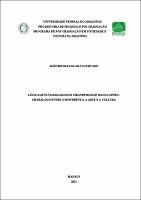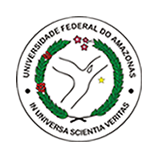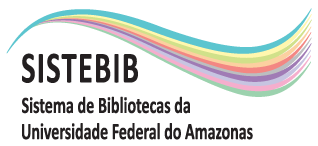| ???jsp.display-item.social.title??? |


|
Please use this identifier to cite or link to this item:
https://tede.ufam.edu.br/handle/tede/10680| ???metadata.dc.type???: | Dissertação |
| Title: | Linguagens no bailado dos cirandeiros de Manacapuru: um diálogo entre o movimento, a arte e a cultura |
| Other Titles: | Languages in the dance of the cirandeiros of Manacapuru: a dialogue between movement, art and culture |
| ???metadata.dc.creator???: | Furtado, João Messias da Silva  |
| ???metadata.dc.contributor.advisor1???: | Wolkoff, Gisele Giandoni |
| First advisor-co: | Soares, Artemis de Araújo |
| ???metadata.dc.contributor.referee1???: | Vasconcelos Neto, Agenor Cavalcanti de |
| ???metadata.dc.contributor.referee2???: | Nogueira, Wilson de Souza |
| ???metadata.dc.description.resumo???: | O trabalho fundamenta-se na ideia de que a cultura popular tem uma relevância significativa no desenvolvimento local, regional e nacional. Considera-se que as manifestações e expressões populares são de grande contribuição para a construção da identidade cultural de um povo. Nosso olhar esteve com foco voltado para aspectos relacionados à vivência em Manacapuru-Amazonas, de modo específico ao Festival de Cirandas de Manacapuru, uma manifestação cultural bastante popular no estado do Amazonas, sendo considerada a segunda maior festividade folclórica do interior do Amazonas e um dos maiores da região norte brasileira. Durante o festival de Cirandas a rotina da cidade é modificada nos mais diferentes aspectos artísticos e culturais, alterando parcialmente a estrutura da sede do municipio, envolvendo os segmentos econômico, social, cultural e educacional. São três agremiações: Flor Matizada, Guerreiros Mura da Liberdade e Tradicional, cada uma delas com características reconhecidas por suas cores. Elas se apresentam em três noites de festival, em que é feito um sorteio para identificação e distribuição de dias específicos para cada uma. Entendemos a contribuição do presente trabalho para comunidade científica e local, por tratar de processos históricos e socioculturais envolvendo sistemas simbólicos como linguagens, signos e manifestações artísticas em festivais. Trata-se de pesquisa descritiva exploratória que objetivou em linhas gerais, investigar as principais percepções dos cirandeiros e cirandeiras com relação ao corpo, observando a linguagem corpórea utilizada nas composições das coreografias no que tange aos aspectos funcionais, estéticos, artísticos e socioculturais, observando o movimento, o ritmo, entre outros, que compõem as Cirandas de Manacapuru-Am, ou seja, consistiu em ir ao campo de pesquisa explorar o objeto de estudo e descrevê-lo, visto que se propôs a compreender o fenômeno a partir dos dados e referências fornecidas pela população estudada. A partir de um olhar fenomenológico nos debruçamos nos estudos de Merleau-Ponty utilizando abordagem qualitativa sobre o corpo e linguagem na manifestação da ciranda em Manacapuru-AM, de onde foram nossos sujeitos da pesquisa, compostos por coreógrafos, cirandeiras e cirandeiros das três agremiações. Diante de cada evidência, ficou claro que por mais que as dinâmicas sejam muito parecidas nas três agremiações, cada indivíduo que compõe este espaço é único, ou seja, cada corpo, do seu jeito, abriga uma maneira de se comunicar, pensar, organizar e se relacionar com o mundo, de acordo com suas vivências nestes espaços. Ele se adapta ou se modifica para dar conta do papel que deve desempenhar no contexto em que está inserido. Esperamos que o trabalho possa constituir-se em um chamamento para novas construções teóricas em torno do tema, por sua importância para a sociedade e cultura amazônica, palco de tantas belezas naturais, históricas e de riqueza de homens e mulheres que se fazem e se refazem a todo instante neste rincão. |
| Abstract: | This work is based on the idea that popular culture has a significant role to play in local, regional and national development. Popular manifestations and expressions are considered to make a major contribution to the construction of a people cultural identity. Our focus is on aspects related to the experience in Manacapuru-Amazonas, specifically the Manacapuru Ciranda Festival, a very popular cultural manifestation in the state of Amazonas, considered the second largest folk festival in the interior of Amazonas and one of the largest in the Brazilian North region. Routine life is changed during this period, in the most different artistic and cultural aspects, partially altering the structure of the city, involving the economic, social, cultural and educational segments. There are three groups: Tinted Flower, Freedom Wall Warriors and Traditional, each with characteristics recognizable by their colors. They perform on three nights of the festival, where a draw is made to identify and allocate specific days for each one deals with historical and sociocultural processes involving symbolic systems such as languages, signs and artistic manifestations at festivals. The research undertaken was descriptive- exploratory and aimed, in general terms hat investigate the main perceptions of the cirandeiros and cirandeiras in relation to the body, observing the corporeal language used in the compositions of the choreographies in terms of functional, aesthetic, artistic and sociocultural aspects, observing the movement, rhythm, among others, that make up the Cirandas of Manacapuru-Am. In other words, it consisted of going to the research field to explore the object of study and describe it, since it was proposed to understand the phenomenon based on the data and references provided by the population studied. From a phenomenological point of view, we looked at Merleau-Ponty's studies using a qualitative approach on the body and language in the manifestation of ciranda in Manacapuru-AM, where our research subjects were choreographers, cirandeiras and cirandeiros from the three associations. Given all the evidence, it became clear that although the dynamics are very similar in the three groups, everyone who makes up this space is unique, that is, each body, in its own way of communicating, thinking, organizing and relating to the world, according to its experiences in these spaces. It adapts or changes to fulfill the role it must play in the context in which it is inserted. We hope that this work can serve as a call for new theoretical constructions on the subject, given its importance for Amazonian society and culture, the scene of so much natural and historical beauty and the wealth of men and women who make and remake themselves all the time in this corner of the world. |
| Keywords: | Danças folclóricas - Amazonas Festas folclóricas - Manacapuru (AM) Ciranda (Dança) |
| ???metadata.dc.subject.cnpq???: | CIENCIAS HUMANAS |
| ???metadata.dc.subject.user???: | Ciranda Linguagem corpórea Festa popular Body language Popular party |
| Language: | por |
| ???metadata.dc.publisher.country???: | Brasil |
| Publisher: | Universidade Federal do Amazonas |
| ???metadata.dc.publisher.initials???: | UFAM |
| ???metadata.dc.publisher.department???: | Instituto de Ciências Humanas e Letras |
| ???metadata.dc.publisher.program???: | Programa de Pós-graduação em Sociedade e Cultura na Amazônia |
| Citation: | FURTADO, João Messias da Silva. Linguagens no bailado dos cirandeiros de Manacapuru: um diálogo entre o movimento, a arte e a cultura. 2024. 99 f. Dissertação (Mestrado em Sociedade e Cultura na Amazônia) - Universidade Federal do Amazonas, Manaus, 2024. |
| ???metadata.dc.rights???: | Acesso Aberto |
| ???metadata.dc.rights.uri???: | https://creativecommons.org/licenses/by-nc-nd/4.0/ |
| URI: | https://tede.ufam.edu.br/handle/tede/10680 |
| Issue Date: | 18-Dec-2024 |
| Appears in Collections: | Mestrado em Sociedade e Cultura na Amazônia |
Files in This Item:
| File | Description | Size | Format | |
|---|---|---|---|---|
| DISS_JoãoFurtado_PPGSCA.pdf | 1.85 MB | Adobe PDF |  Download/Open Preview |
Items in DSpace are protected by copyright, with all rights reserved, unless otherwise indicated.




